Over the 50 seasons the Vancouver Canucks have been in existence, 12 general managers (GMs) have led the team from the front office. Being a GM is not easy, they have to constantly deal with the coaching staff, player agents, and the media on a daily basis and face criticism no matter what they do. Not to mention ownership is always breathing down their back to consistently succeed and make them money.
Like every team, the Canucks have had their good and bad GMs over the years. Some stand out more than others on both the positive and negative side, but all of them have brought franchise icons and fan favourites to the team at one point or another. With the current GM, Jim Benning seemingly reaching the end of the road on his tenure, I took a stab at ranking all the GMs in franchise history. So, without further ado, let’s get to the countdown!
12. Mike Keenan (1997-1998) Acting
Mike Keenan deserves a mention, but not in the positive sense. After Quinn was fired at the beginning of November during the 1997-98 season, he took over as acting GM for the Canucks and ended up making a trade that still lives on in infamy. Yes, he was the one that traded franchise icon, Trevor Linden.
Keenan and Linden had a difficult relationship which was compounded after Mark Messier was signed and given the captaincy, seemingly of Linden’s own free will. So Keenan thought it best to trade away his problem child and run with the declining 37-year-old Messier.
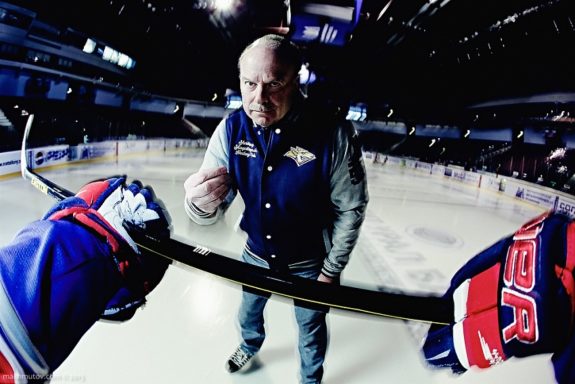
It turned out to be the wrong decision, as Messier went on to have his worst years in Vancouver and create drama in both the locker room and the city itself. It was without a doubt, one of the darkest times in Canucks history.
Trading Linden to the Islanders did do one good thing, it brought Todd Bertuzzi to the Canucks and helped eventually create the vaunted West Coast Express featuring Markus Naslund and Brendan Morrison. So I guess there was a silver lining to the mess created by Keenan.
11. Hal Laycoe (1973-1974)
Hal Laycoe was the second GM of the Canucks, but only for less than a season. He took office in April of 1973 after coaching the team for two seasons and was dismissed shortly thereafter in January of 1974. He did make one significant trade a month before he left when he acquired future 30-goal scorer John Gould from the Buffalo Sabres, but that’s about it. He also ran one draft in 1973 where a couple of standouts in Dennis Ververgaert and Bob Dailey were selected. They both ended up playing over 500 games in the NHL. But given his relatively short tenure, Laycoe hangs out at the bottom of this list.
10. Jack Gordon (1985-1987)
Jack Gordon took over as Canucks GM in 1985 and ran the team until 1987. Under his leadership, they made the playoffs twice. Like Laycoe, he was also a former head coach, leading the Minnesota North Stars for five seasons and becoming their GM for two seasons afterward. Over the three seasons Gordon was GM, he made six trades. Many of them were relatively unspectacular in impact, except for two, which were ironically his best and worst trades during his tenure. As for drafting, he selected 23 players and had nine of them play at least one game in the NHL for a success rate of 39 percent.
Gordon will forever be known as the GM that traded future Boston Bruins’ legend and Hall of Famer Cam Neely. Unfortunately, that alone makes him one of the worst GMs they ever had. Even though he did have a decent track record at the draft and built two teams that made the playoffs, that will always hang over his head and keep him at the bottom of any set of rankings.
Gordon’s Highs & Lows
Best Trade: Jean-Jacques Daigneault, Kent Hawley & Sean Fabian for Rich Sutter, Dave Richter & Don Gibson
Gordon’s best trade was without a doubt the deal he made with the Philadelphia Flyers for Rich Sutter and Dave Richter. We’ll get to his all-time worst in a second.
Richter was a 6-foot-5 mountain of a man that was both physical and menacing on the ice. He was also a frequent resident of the penalty box that finished his career with 1,030 penalty minutes in only 365 games played. He had a modicum of success with the Canucks posting four goals and 23 points including a career season in 1986-87 when he recorded 17 points in 78 games.
Sutter was the centerpiece of the deal. At 23-years-old, he was a budding top-six forward with a bright future and he showed it multiple times during his time in Vancouver. He ended up playing three seasons on the West Coast and hit career-highs in goals (20), points (42), and shooting percentage (13.6 percent). By the end of his tenure, he had accumulated 52 goals and 104 points in 229 games.
The draft pick turned out to be a bust as Gibson only ever played 14 games in the NHL, but at least the Canucks got two players that contributed to the team for a while. The Flyers got the butt end of the deal, as Daigneault only played two seasons with the club, and Hawley and Fabian never played a game in the NHL.
Worst Trade: Cam Neely for Barry Pederson
Trading Neely was hands down Gordon’s worst trade as a GM in the NHL. Yes, they got a relatively productive player in Barry Pederson, but he never got close to the level Neely did in Boston.
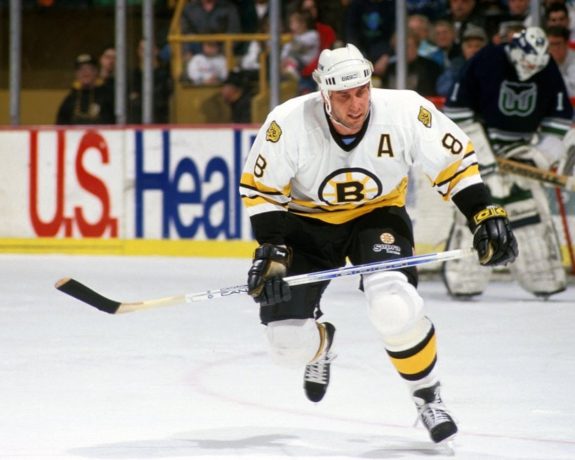
Pederson couldn’t re-produce his insane start to his career when he posted three-straight 30-goal seasons and two 100-point campaigns and ended up being a massive disappointment. In fact, he only ever scored a high of 24 goals in a Canucks uniform despite posting two-straight 70-plus point seasons.
Neely, on the other hand, went on to record 344 goals and 590 points in 525 games with the Bruins, which included three 50-goal seasons, four All-Star selections, and a Bill Masterson Trophy in 1994. He was inducted into the Hockey Hall of Fame in 2005 and is currently the president of the Bruins.
The Canucks also gave up a first-round pick in the deal if you can believe it. The pick turned out to be long-time Carolina Hurricanes’ and Bruins’ defenceman Glen Wesley at third-overall. He played 1,457 games in the NHL and ended his career with 128 goals and 537 points. Basically, it was lopsided trade, probably one of the biggest in NHL history.
Best Draft Pick: Igor Larionov (1985, 214th overall)
Gordon presided over two drafts and selected 23 players. Among the standouts was Detroit Red Wings legend Igor Larionov. A lot of people forget that he was not only drafted by the Canucks, but played three seasons with them between 1989 and 1992. He also scored 51 goals and 143 points in 210 games.
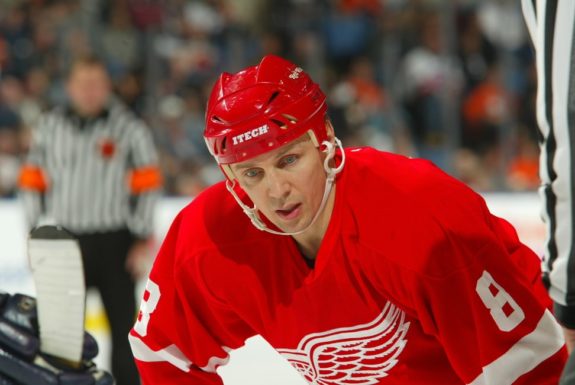
Larionov ultimately played most of his career with the Red Wings, but the astute drafting of Gordon and his team of scouts found him in the 11th round, a round that doesn’t even exist anymore in the modern NHL. He finished his career with 169 goals and 644 points in 921 games.
Worst Draft Pick: Dan Woodley (1986, 7th overall)
When a top-10 pick only plays five games and scores two goals in his career, something is wrong. Though that’s exactly what happened with center Dan Woodley. After an impressive draft year with the Portland Winterhawks where he recorded 45 goals and 92 points in 62 games, he was touted as a future top-six forward. Except he never became one, and the Canucks lost out on future stars like Brian Leetch and Scott Young, who were drafted a few picks after him.
9. Phil Maloney (1974-1977)
Phil Maloney took over from Laycoe at the beginning of 1974 and held the job until 1977. His teams won the division and made the playoffs twice during his reign. He also presided over three amateur drafts and selected 25 players. Of those 25, 12 played at least one game in the NHL, giving him a 48 percent success rate.
Maloney’s Highs & Lows
Best Trade: Dave Dunn for Garry Monahan & John Grisdale
Of the 11 trades Maloney made during his tenure, this one is by far his best. Yes, Dunn was a promising 25-year-old defenceman who had just recorded 11 goals and 33 points in his rookie season, but that ended up being his best in the NHL. After he was traded to the Leafs, he only posted 22 points in two seasons and then joined the WHA to finish his career.
Grisdale and Monahan, on the other hand, played a combined nine seasons with the Canucks and were key parts of the team too. Grisdale was a regular on the blue line and recorded three goals and 35 points in 199 games and Monahan was a productive middle-six forward with 58 goals and 82 points in 287 games. He also had four straight seasons where he hit double-digits in goals.
Worst Trade: Curt Ridley
Basically the Canucks traded a high first-round pick for a goaltender that only provided average goaltending as a backup to Cesare Maniago. They also lost out on draft picks like Paul Gardner and Peter Lee, who both recorded over 400 games in the NHL.
Best Draft Pick: Harold Snepsts (1974, 59th overall)
Just months after Maloney was hired as GM, he helped run the 1974 Draft and drafted a future icon and fan favourite in Harold Snepsts. As a fourth-round pick, he ended up playing 1,033 games for the Canucks and was one of their best two-way defencemen for over a decade. He also was a mean customer, always standing up for his teammates and throwing big hits whenever the opportunity presented itself.
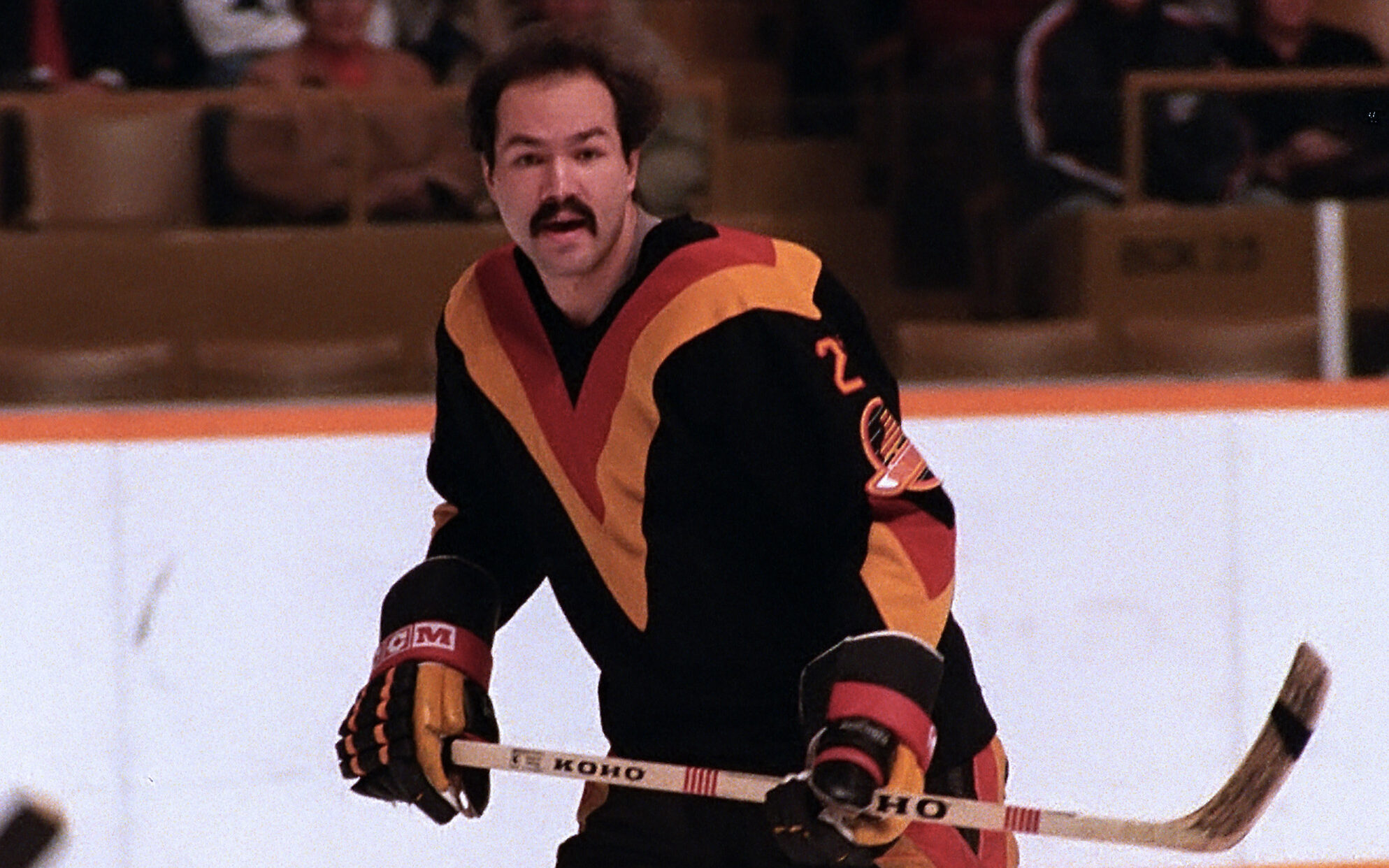
Over the course of his time with the team, he won four Walter “Babe” Pratt Trophies for best defenceman and the Fred J. Hume Award as an unsung hero. Finally, he also was a major part of the team that went all the way to the Stanley Cup Finals in 1982. He was rightly inducted into the Ring of Honour in 2011.
Worst Draft Pick: Brad Gassoff (1975, 28th overall)
Maloney didn’t have many horrible draft picks, but if I had to pick one, it would be Brad Gassoff. He was a second-round pick after scoring 50 goals and 109 points in 69 games with the Kamloops Chiefs of the WCHL, but only ever scored a career-high nine goals in the NHL. He also only played 122 games and never lived up to the billing of the rugged goal scorer he was in junior.
8. Jim Benning (2014-present)
After Mike Gillis was fired in 2014, Jim Benning was hired as the Canucks’ 12th GM, a title he still holds today. His teams have only made the playoffs twice, but his drafting has probably set the team up for decades to come. Core players like Elias Pettersson, Quinn Hughes, Brock Boeser, and Thatcher Demko were all selected by him and are already stars in the NHL. Not to mention, future stars like Nils Hoglander, Vasily Podkolzin, and Jack Rathbone are just waiting in the wings.
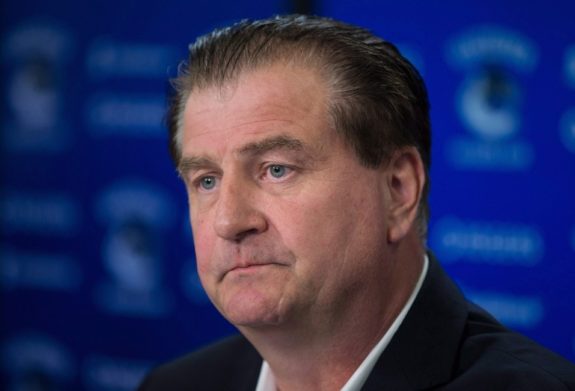
However, if not for his successful work on the draft floor, he would be toiling at the bottom of this list. His trades have brought players like J.T. Miller, Nate Schmidt, Tanner Pearson, and Tyler Motte to the team, but have also lost solid prospects and players like Jared McCann, Tyler Madden, and Nick Bonino to other teams. His free-agent signings of Loui Eriksson, Jay Beagle, and Antoine Roussel have also put the Canucks in a horrible salary cap position going into the contract years of Pettersson and Hughes.
If Benning can find a way to supplement the Canucks with enough budget-friendly talent beyond his two superstars, he may just lead this team to a Stanley Cup in the future. Unfortunately, after six seasons of his leadership, that seems like a pipe dream. The more likely scenario will be another GM picking up the pieces and benefiting from his drafting just like Mike Gillis did during his reign.
Benning’s Highs & Lows
Best Trade: J.T. Miller
All Miller has done since joining the Canucks is produce. He’s already over 100 points wearing the blue and green, and he’s become an integral part of the team’s core too. Not bad for a player that has only been on the West Coast for a little over a season.
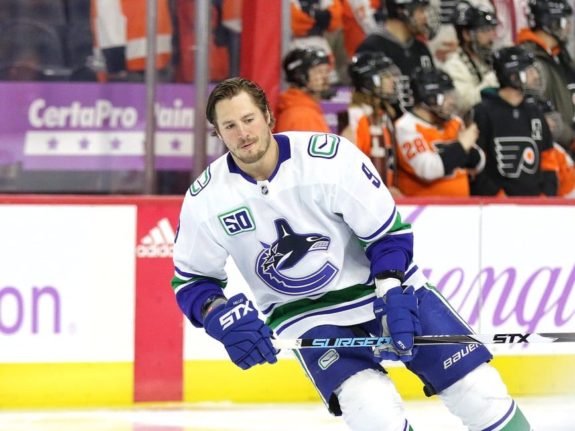
In 106 games, he has 36 goals and 103 points mostly playing on the top line with Pettersson and Boeser. Long story short, this trade has worked out very well for Benning and the Canucks.
Worst Trade: Erik Gudbranson for Jared McCann
When the Canucks made this deal back in 2016, it was a bit of a head-scratcher. Gudbranson wasn’t really what they needed at the time, and McCann should have been part of the rebuild that was just getting underway. The trade didn’t take long to look bad as Gudbranson struggled to keep up with the pace of the new NHL, and although McCann didn’t start to produce until he was in Pittsburgh, he is now a solid NHLer capable of putting up 15-20 goals.
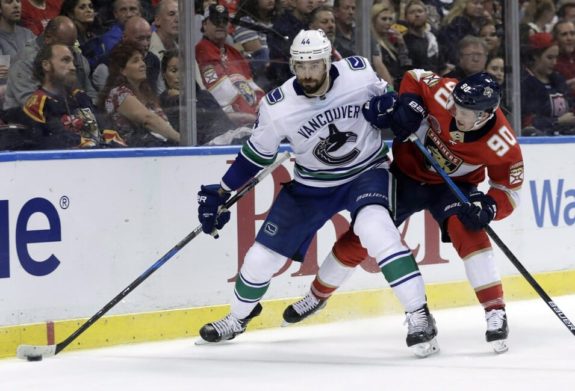
Gudbranson has since moved on to the Pittsburgh Penguins, Anaheim Ducks, and Ottawa Senators, and is now a member of the Nashville Predators after he was traded there at the 2021 Trade Deadline. All in all, he’s on his fourth team in three seasons and has failed to live up to his lofty third overall selection back in 2010. Suffice it to say, McCann was definitely a talented forward that got away from the Canucks.
Best Draft Pick: Quinn Hughes (2018, 7th Overall)
You could make a legitimate argument for Pettersson here, but it’s far more difficult to find franchise defencemen in the draft than forwards. From the minute Hughes stepped onto the ice for the Canucks, he looked like a special player. His smooth skating and insane hockey IQ were on display all game long as he recorded his first NHL point after banking the puck to himself behind the net and setting up Boeser for a goal. He then followed that up with a record-setting rookie season where he racked up 8 goals and 53 points in 68 games. If not for Cale Makar’s equally impressive first campaign, he would have won the Calder Trophy as the NHL’s best rookie.
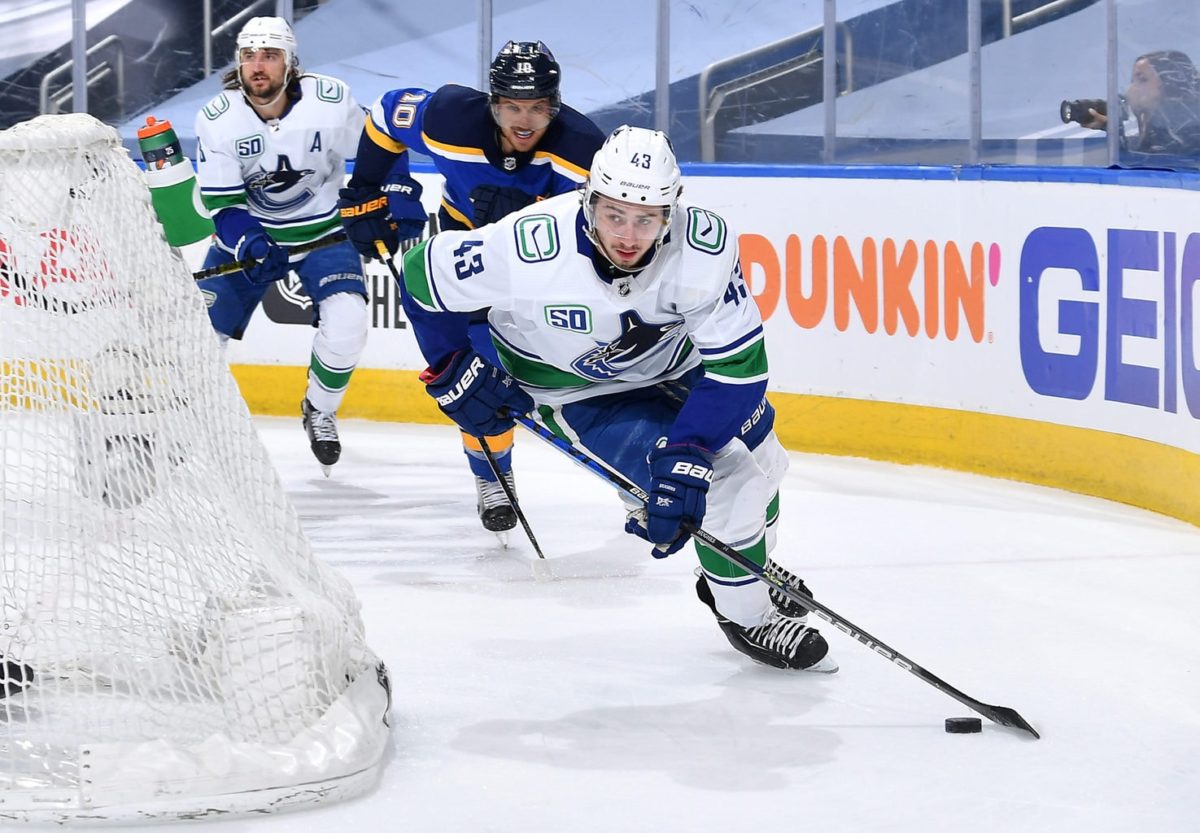
Now Hughes is the Canucks’ number one defenceman, logging close to 25 minutes a night and marching closer and closer to a big payday which he rightly deserves.
Worst Draft Pick: Jake Virtanen (2014, 6th Overall)
Jake Virtanen’s struggles to gain a foothold in the NHL have been well documented in Vancouver. From his lack of work ethic and consistency to his sometimes questionable attitude on and off the ice, he has definitely not lived up to his draft position. When you look at the tools he has to work with, it’s hard to understand why he hasn’t put it all together at the NHL level yet. He has the speed, size, and shot to succeed, but not the hockey IQ, which is arguably the most important skill to have. When you look at the point totals William Nylander, Nikolaj Ehlers and Dylan Larken have put up so far, it’s hard to argue that his selection was a good one.
7. Harry Neale (1982-1985)
Before Harry Neale was a colour-man on Hockey Night in Canada, he was GM of the Canucks. Between the years of 1982 and 1985, his teams made the playoffs twice but never made it past the second round. He also coached the team for parts of six seasons, including two where he wore the hats of GM and coach at the same time. Finally, he ran three drafts and selected 36 players including Neely in 1983 with the ninth overall pick. Overall, 12 of them played at least one game in the NHL for a 33 percent success rate.
Neale’s Highs & Lows
Best Trade: Curt Fraser for Tony Tanti
Like J.T. Miller of the modern-day Canucks, the trade that brought Tanti to the Canucks turned out to be one of the franchise’s best. After playing only three games in a Blackhawks’ uniform, he joined the team as a fresh-faced 19-year-old and proceeded to shout to the NHL that he was a goal scorer ready to take the league by storm.
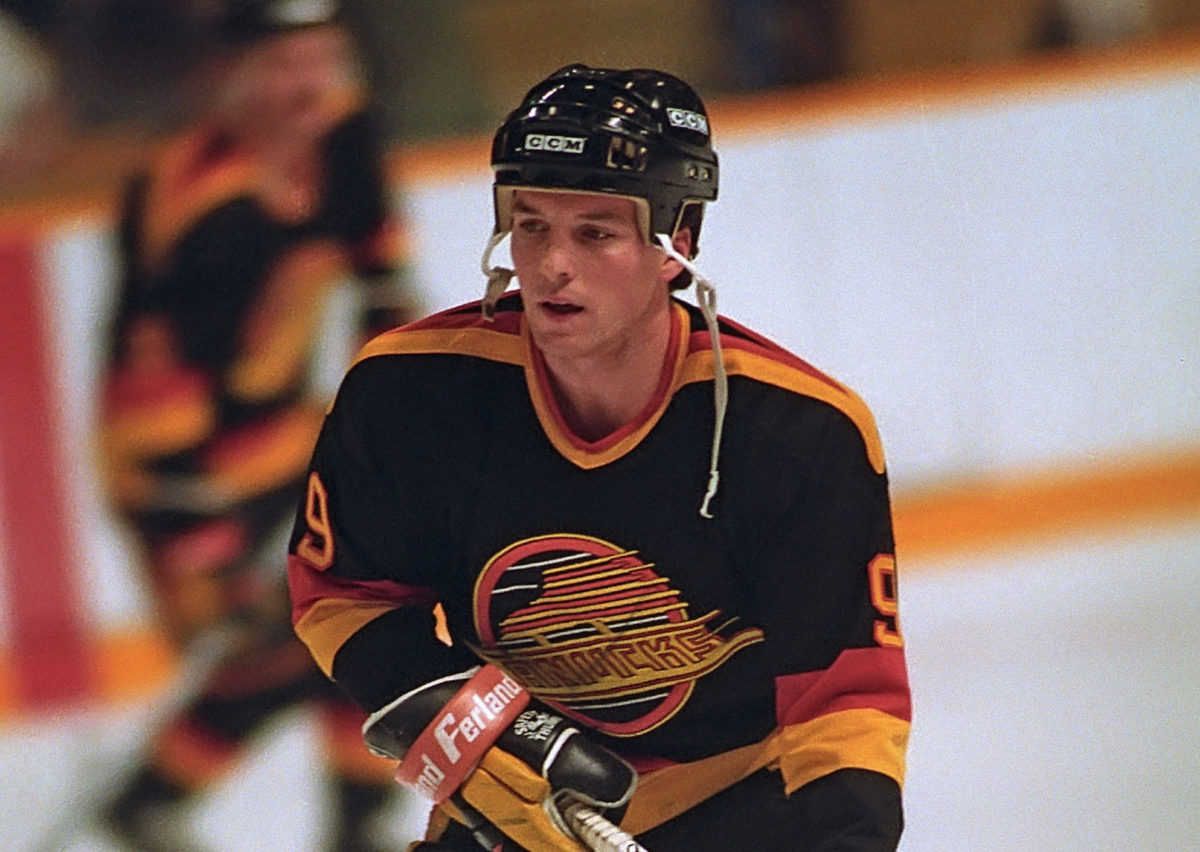
Over the next five seasons, Tanti scored 204 goals and nearly had five straight 40-goal campaigns too. In fact, he was only one off of the total during two of those seasons. He still ranks sixth in franchise scoring for the Canucks with 250 goals and is widely known as one of their most prolific goal scorers of all time.
Worst Trade: Tiger Williams for Rob McClanahan
After quite a few seasons of storied success with the Canucks, Neale traded fan favourite Tiger Williams to the Red Wings. The return was okay at the time as they received a potential goalscorer in the 26-year-old McClanahan who just finished a 22-goal season with the New York Rangers, but he ended up never suiting up with the Canucks. Instead the Canucks lost an abrasive two-way grinder in Williams for nothing.
Granted Williams appeared to be trending down, but he still could score and provide toughness as he showed regularly with the Los Angeles Kings when he had another 20-goal season and over 300 penalty minutes just a couple of seasons after the trade. Williams ended his career ranked fifth in all-time penalty minutes, even though he only played 312 games on the West Coast.
Best Draft Pick: Cam Neely (1983, 9th overall)
By a country mile, Neely was Neale’s best selection as a GM. He was probably a bit of a slam-dunk at ninth-overall, but nevertheless, he turned out to be quite the pick even though he was ultimately traded away to the Bruins. As I mentioned before, he’s now a Hall of Famer, Stanley Cup champion, and multiple award winner in the NHL and arguably one of the best power forwards of all time.
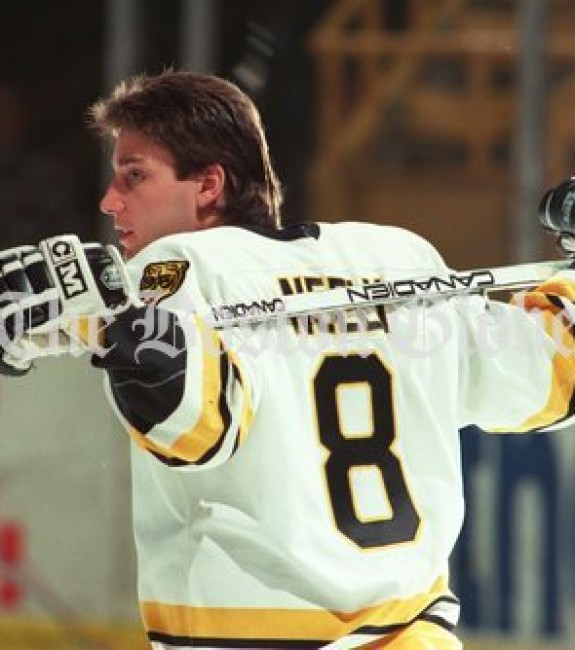
The runner-up probably would be 1983 sixth-round pick Dave Lowry, who ended up playing over 1000 games in the NHL while posting 164 goals and 351 points, but I think a legend like Neely rises to the top in this case.
Worst Draft Pick: Jeff Rohlicek (1984, 31st overall)
Neale seemed to find a lot of success at the top of the draft with most of his first and second-round picks ending up as long-term players in the NHL. Jeff Rohlicek was not one of them as he only lasted nine games and never put up any points. He did find a modicum of success in the IHL and ECHL, but couldn’t do much at the NHL level.
6. Dave Nonis (2004-2008)
Dave Nonis became GM of the Canucks after Brian Burke was fired in May of 2004. Famously known for acquiring future Hall-of-Famer Roberto Luongo from the Florida Panthers, he oversaw only one playoff appearance and a division title, which coincided with the first season Luongo was the starting goaltender. He also ran the 2004 Draft, which is still considered one of the most successful ones in franchise history. Of the seven selections he made that year, four went on to play over 400 games in the NHL and two of them, Alex Edler and Jannik Hansen became franchise cornerstones who will probably see their names in the Ring of Honour someday.
Nonis’ Highs & Lows
Best Trade: Todd Bertuzzi, Bryan Allen & Alex Auld for Roberto Luongo & Lukas Krajicek
Nonis ultimately made 24 trades when he was GM of the Canucks, but none of them was the blockbuster that was the Luongo trade. After five seasons with the Panthers, he joined the Canucks in a deal that involved fan favorite Todd Bertuzzi. At the time, it was a pretty even trade for both sides, but it only took a couple of seasons to become a landslide in favour of the Canucks.
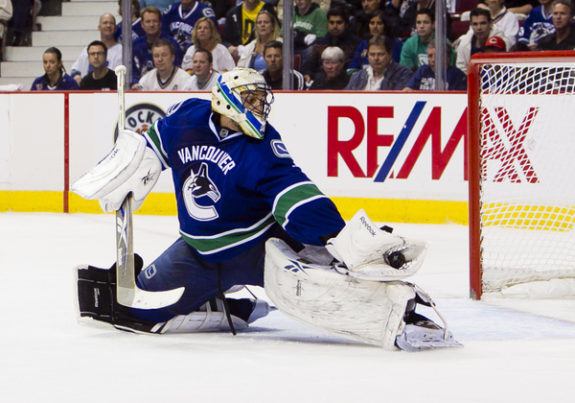
Bertuzzi only played seven games in an injury-shortened season with the Panthers, and then got traded again, this time to the Detroit Red Wings. In the end, they lost the central piece of the trade before the season was ten games old and the Canucks gained a franchise goaltender who is still first in all-time wins (252) and shutouts (38). He also was captain of the team for two seasons and led them to two President’s Trophies, and a Stanley Cup Final appearance in 2011. Needless to say, his acquisition ended up being a major coup for Nonis.
Worst Trade: Matt Cooke for Matt Pettinger
Other than the Luongo trade, Nonis only ever made small deals that never amounted to anything substantial. Except, he did make a few trades that probably shouldn’t have been made at all. Trading away the versatile Matt Cooke was definitely one of them. Pettinger was a younger, more skilled option, but he was no Cooke.
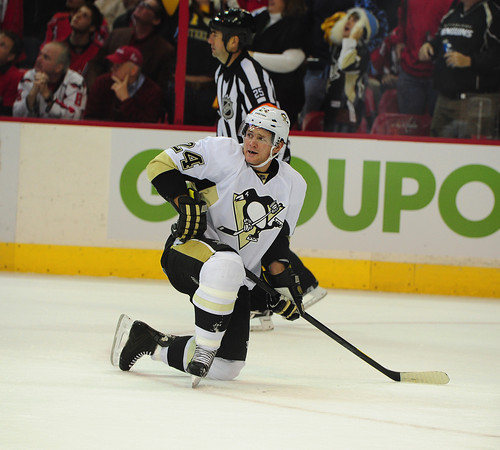
Cooke didn’t end up playing for the Capitals for more than half a season, but he did play seven more seasons in the NHL and only ever dropped below ten goals twice. He also won a Stanley Cup with the Penguins in 2009 and was an integral part of the bottom-six that frustrated teams all throughout the playoffs. I wager the Canucks could have used that type of presence in their lineup against the Boston Bruins in 2011, that’s for sure. Then, when you throw in the fact that Pettinger only played 29 games in a Canucks uniform, the optics of the trade look even worse for Nonis and his staff.
Best Draft Pick: Alex Edler (2004, 91st Overall)
Nonis had his moments at the draft for the Canucks. 2004 was definitely his best when he selected now-veteran Swedish defenceman, Alexander Edler. Most of the credit should go to scout Tomas Gradin, who trekked down to Edler’s hometown of Östersund to watch him play. Reportedly only the Red Wings were scouting him, so if Gradin didn’t go down there, he probably would have been drafted by them.
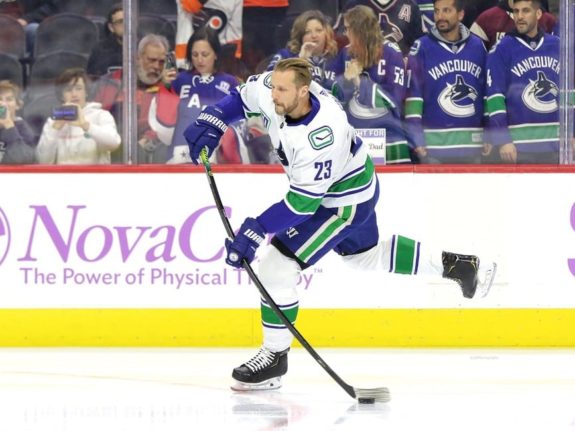
Though that didn’t happen and Edler now is one of the best defencemen in Canucks history. In his 15th season with the team, he leads all defencemen in goals (99), points (407), and games played (910) and is only one goal away from 100 in the NHL. Not to mention he’s still a top-pairing defenceman at 34-years-old. Not bad for a third-round pick.
Worst Draft Pick: Patrick White (2007, 25th overall)
If the 2004 Draft was Nonis’ best, then the 2007 one was by far his worst. Of the six selections he made that year, a grand total of zero made it to the NHL. Patrick White, who was his first selection out of the USHL’s Tri-City Storm never even saw the inside of an AHL arena, let alone an NHL one. In his draft year, he was touted as one of the most complete players in the draft but ended up being a bust. He was ultimately traded by the Canucks to the Sharks for Ehrhoff and then went unsigned by them after four seasons with the University of Minnesota. He bounced around Europe for six seasons, then dropped off the map after playing with Dijon in France. His best season came in 2011-12 when he scored 32 goals playing for Klostersee EHC in Germany.
5. Bud Poile (1970-1973)
Bud Poile ran the Canucks front office for the first three years of its existence. He oversaw the expansion draft where he selected future legends, Orland Kurtenbach and Pat Quinn, and then eventually drafted long-term NHLers Don Lever, Dale Tallon, Jocelyn Guevremont, Richard Lemieux, and Bobby Lalonde.
Of the 23 selections Poile made in the NHL Amateur Draft, 14 played at least one game in the NHL, giving him a success rate of nearly 61 percent. His teams didn’t have much success on the ice, but he did build a solid foundation for a franchise that is over 50 years old now. His son, David Poile is the current GM of another expansion team, the Nashville Predators who he has run for nearly 23 years.
Considering Poile was the GM of two expansion teams that still exist today in the Canucks and Philadelphia Flyers should tell you all you need to know about his ability to lead a team from the front office. He also became executive vice-president of the World Hockey Association (WHA) and commissioner of the International Ice Hockey League (IHL) later in his career which eventually led him to be inducted into the Hockey Hall of Fame as a builder. All in all, I think the Canucks chose the right man for the job when they named him their first-ever GM in 1970.
Poile’s Highs & Lows
Best Trade: Andre Boudrias
Without a doubt, Poile’s biggest trade was the acquisition of Andre Boudrias. Like Tanti was for Neale, Boudrias was for Poile. He became a consistent offensive contributor for the Canucks with three straight seasons of 20 or more goals and currently sits 20th in franchise scoring.
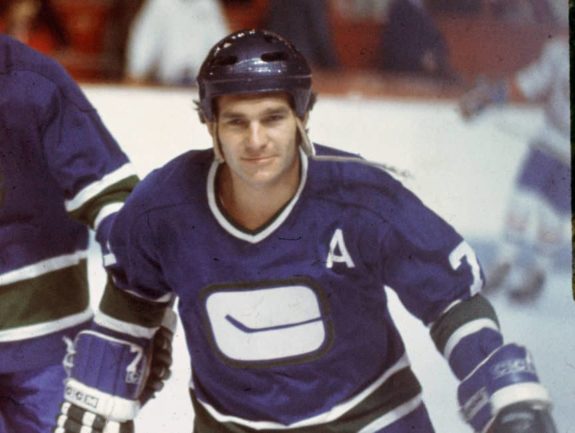
Considering Boudrias only cost two very low draft picks, Poile made out like a bandit with this trade.
Best Draft Pick: Don Lever (1972, 3rd overall)
Of all the successful draft picks Poile had in Tallon (336 points in 642 games), Richard Lemieux (121 points in 274 games), Bobby Lalonde (334 points in 641 games) and Jocelyn Guevremont (307 points in 571 games), Don Lever was by far his best. After being selected third overall in the 1972 NHL Amateur Draft, he went on to have eight productive seasons with the Canucks posting five 20-goal campaigns and even a 30-goal one during the 1974-75 season. He is currently ranked 11th on the all-time scoring list with 186 goals.
Surprisingly No Bad Trades or Draft Picks
Of the 20 trades and 23 draft picks Poile made, none of them stood out as bad. I couldn’t find a single one that I could fairly criticize, which is surprising considering most GMs have at least one that sticks out like a sore thumb.
4. Mike Gillis (2008-2014)
Of all the teams the Canucks have had over the years, player agent-turned-GM Mike Gillis presided over three of the best. Some say his successful seasons as GM were a product of the previous work of Nonis and Brian Burke, which may be true since the Sedins, Luongo, Edler, Ryan Kesler, and Alex Burrows were all acquired by those regimes. Though Gillis did trade for and sign some key components as well including Manny Malhotra, Christian Ehrhoff, Dan Hamhuis, Chris Higgins, Maxim Lapierre, and Raffi Torres. So maybe it was more a team effort than just one man. Nevertheless, he was the GM of the team during those years, which make those seasons his successes, not there’s.
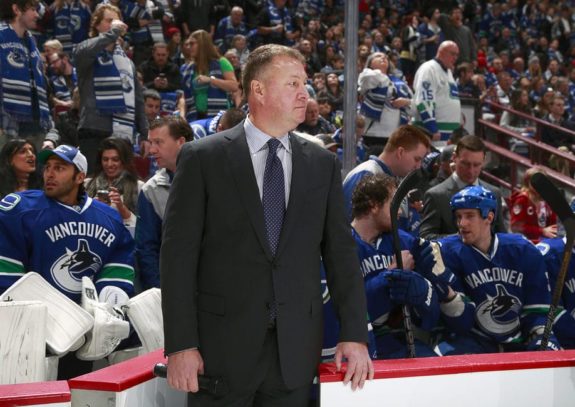
Gillis also introduced out-of-the-box thinking like sleep doctors and was very good at managing the salary cap along with his right-hand man Laurence Gilman. So, in the end, despite some major hiccups with Luongo and Cory Schneider, he was one of the most successful GMs the Canucks ever had. Overall, he led the Canucks to two Presidents’ Trophies, one conference title, five division titles, five playoff appearances and came within one win of the Stanley Cup in 2011. He also won the General Manager of the Year Award that year too. That’s quite the resume, which gets him just outside the top three on this list.
Gillis’ Highs & Lows
Best Trade: Patrick White & Daniel Rahimi for Christian Ehrhoff & Brad Lukowich
This may have been a cap dump for the San Jose Sharks, but this trade turned out to be Gillis’ best as a GM. Ehrhoff became a dominant top-four defenceman for the Canucks, running the attack from the back end with two seasons of 40 points or more, and White and Rahimi never played in the NHL. It was as lopsided of a trade as you could get.
Worst Trade: Kevin Connauton for Derek Roy
Gillis made some great trades, but he also made some bad ones too. This one was probably his worst of all, considering Connauton is still playing in the NHL and Roy has since retired. Roy was also just a rental and a bad one at that. He ended up only playing 16 games with the team and was not a very big producer either, scoring only three goals.
Best Draft Pick: Bo Horvat (2013, 9th Overall)
If Horvat never realized his potential as a top-six forward with the qualities of a future captain, he would also be part of the worst trades in Gillis’ tenure. Except he did, and he is now his best draft pick. Horvat has become everything and more for the Canucks in his career so far.
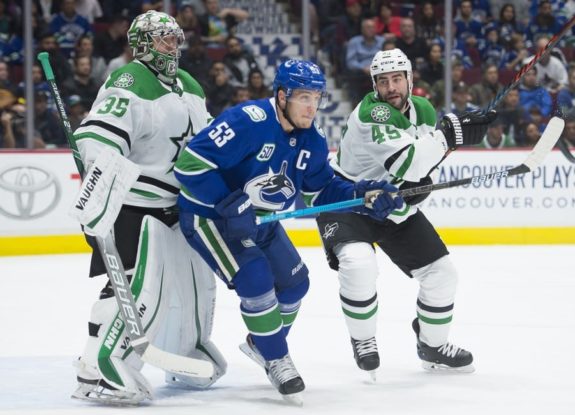
Now in his seventh season with the team, Horvat wears the C and has scored at least 20 goals in four straight campaigns. Cut from the same fabric as Smyl and Linden, he will probably go down as one of the best captains in the history of the franchise, just like his predecessors.
Worst Draft Pick: Hunter Shinkaruk (2013, 24th Overall)
From the best to the worst, in the same draft, no less. Once thought of as Horvat’s future winger, Shinkaruk never realized even a quarter of his potential. He definitely had all the skills of a goal scorer, but never put it together at the highest level. After being traded to the Flames for Markus Granlund in 2016 and then to the Canadiens for Kirby Rychel in 2018, he is now playing in the KHL after only 15 games in the NHL.
3. Jake Milford (1977-1982)
Jake Milford was hired in 1977 by the Canucks and ended up being one of their most successful GMs. His teams made the playoffs four times, won a conference title, and made it all the way to the Stanley Cup Final against the powerhouse New York Islanders in 1982.
Most of his trades were home runs too, as he acquired legends like Richard Brodeur, Tiger Williams, Darcy Rota, and Thomas Gradin. He also ran five very solid drafts where he selected a staggering 21 players who went on to play over 100 games in the NHL. In fact, of the 42 players he selected, only 12 never played a game on the biggest stage. That’s a 71.4 percent success rate, which is almost unheard of for most GMs. It’s no wonder he was selected in the builder category for the Hockey Hall of Fame in 1984.
Milford’s Highs & Lows
Best Trade: Steve Ludzik for Thomas Gradin
Ranking in the same realm as the Miller trade by Benning, Milford got away with robbery when he made this deal with the Blackhawks in the summer of 1978. Gradin instantly became a lethal goal scorer with the Canucks, recording his first 20-goal campaign and subsequently posting six-straight seasons with 20 or more goals. He even had three 30-goal seasons during that span.
Overall, Gradin scored 197 goals and 550 points in 613 career games with the Canucks. Steve Ludzik, who was drafted with the second-round pick, never eclipsed 11 goals and ended up being just a utility player at the NHL level. It doesn’t take a mathematician to see who won this trade.
Worst Trade: Rick Vaive & Bill Derlago for Tiger Williams & Jerry Butler
Before the infamous Neely trade, there was this one. Tiger Williams may have become a fan favourite with the Canucks, but Derlago and Vaive became prolific goal scorers for the Toronto Maple Leafs with Vaive hitting the 50-goal plateau in three straight seasons. By the end of their respective careers with the Leafs, they had piled up 457 goals and 871 points between them and were legitimate stars in the NHL.
Williams could only muster one 35-goal season with the Canucks and ended up being more of a depth scorer than a top-six threat. With the team making it to the Stanley Cup Final in 1982, you can’t help but wonder what Vaive and Derlago could have done to turn the tide against the Islanders. Although, with the firepower they possessed, I doubt they would have made much of a difference. Regardless, this trade remains up there with Neely as one of the worst trades in franchise history.
Best Draft Pick: Stan Smyl (1978, 40th Overall)
When you look at what Stan Smyl accomplished with the Canucks, you can’t help but choose him as Milford’s best draft pick, if not one of the franchise’s best of all-time. He was the first Linden, a consummate leader on and off the ice, and the hardest working player night in and night out.
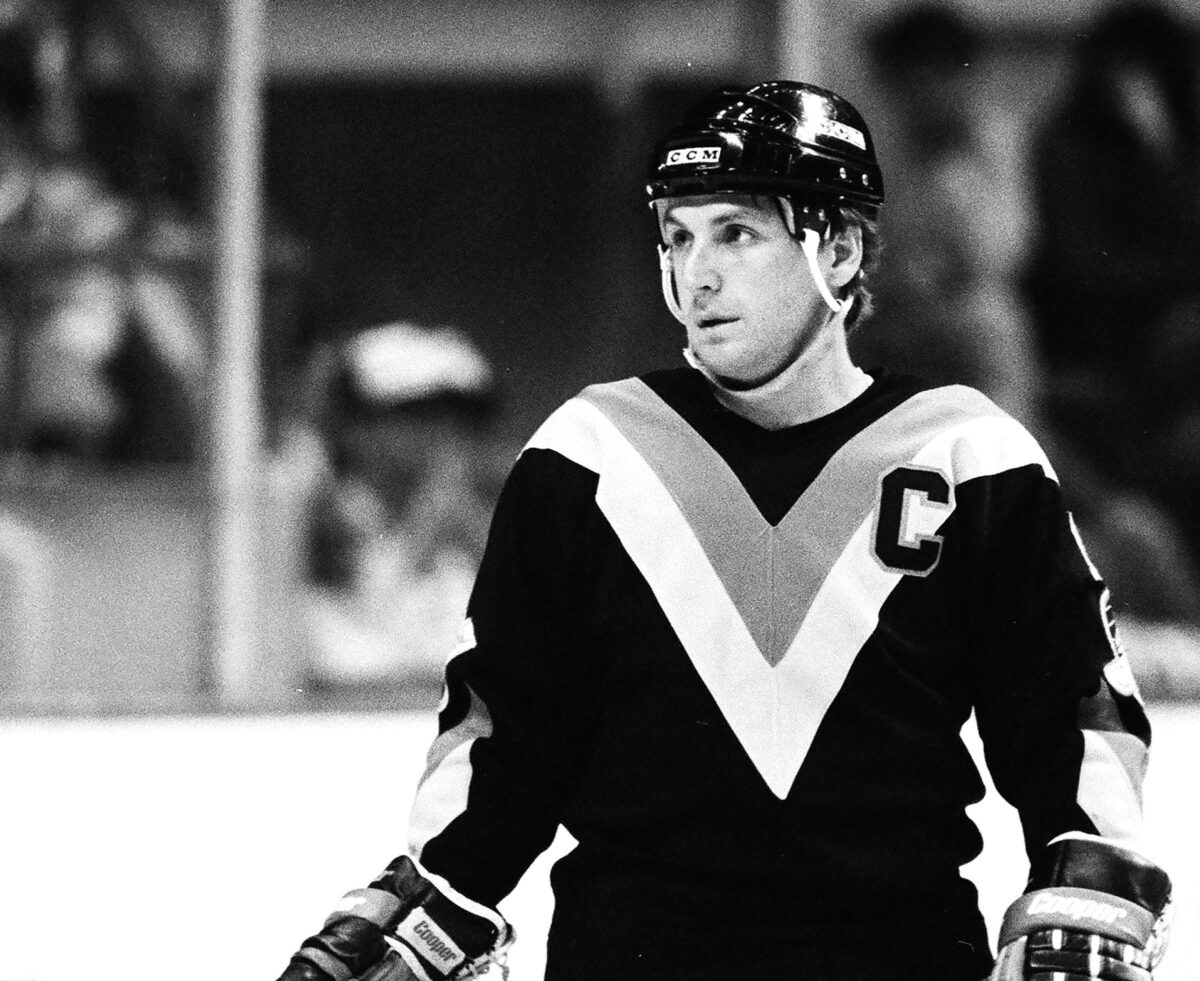
Smyl ended his NHL career as a Canucks’ legend and his number is now hanging in the rafters at Rogers Arena. He continues to be a fixture there too, as he’s never played or worked for another organization, even in retirement.
No Bad Draft Picks
Milford and his team of scouts made quick work of every draft they were a part of. Every first-round pick they chose played over 300 games in the NHL, and they even had some steals in Dirk Graham (89th overall), Patrick Sundstrom (175th overall), Doug Lidster (133rd overall), and Petri Skriko (157th overall) who were drafted beyond the fourth round that played over 500. They didn’t know the meaning of the word bust.
2. Brian Burke (1998-2004)
Burke’s history with the Canucks has been well documented, mostly because of the many trades that he made on the 1999 NHL Draft floor to select the legendary Sedin twins. He also traded for long-time Canucks Ed Jovanovski, Sami Salo, Dan Cloutier, and Brendan Morrison and returned Linden to his rightful place in Vancouver. His draft record produced some greatest hits in Ryan Kesler, Kevin Bieksa, Bryan Allen, Artem Chubarov, and Jarkko Ruutu, but also some duds in Nathan Smith, Kirill Koltsov, and Marc-Andre Bernier. Of the 54 players he drafted, 16 of them played at least one game in the NHL, giving him a rather mediocre success rate of 29.6 percent. If not for the Sedins, his record at the draft table would look rather pedestrian.

Under Burke’s watchful eye, the Canucks came out of the dark ages of Keenan with some of its most exciting hockey ever. When Stanley Cup-winning coach and former Canuck Marc Crawford took over behind the bench and the West Coast Express of Naslund, Morrison, and Bertuzzi got rolling, every day seemed brighter. Unfortunately, he could not lead them to a Stanley Cup and had to settle for four playoff appearances and a division title instead. Nevertheless, he remains one of the most impactful and outspoken GMs they ever had.
Burke’s Highs & Lows
Best Trade: Alex Mogilny for Brendan Morrison & Denis Pederson
At first glance, this trade doesn’t look like a winner, especially when you look at the names involved in it. Considering Alex Mogilny was a superstar and Morrison and Pederson were depth forwards, it actually didn’t look good at all. Fortunately for Burke and the Canucks, Morrison developed tremendous chemistry with Bertuzzi and Naslund, and the rest, as they say, is history. By the end of his tenure with the team, he had scored 136 goals and 393 points in 543 career games and transformed into a leader not only on the ice but in the community as well.
Worst Trade: Martin Grenier & R.J. Umberger for Martin Rucinsky
Like most rentals at the trade deadline, the renters usually don’t come out on top, unless they win the Stanley Cup because of said rental. That did not happen for the Canucks as they got eliminated in the first round against the St. Louis Blues, and Martin Rucinsky signed with the New York Rangers in the offseason. To make matters worse, R.J. Umberger turned into a perennial 20-goal scorer with the Philadelphia Flyers and Columbus Blue Jackets and ended up playing 779 games in the NHL.
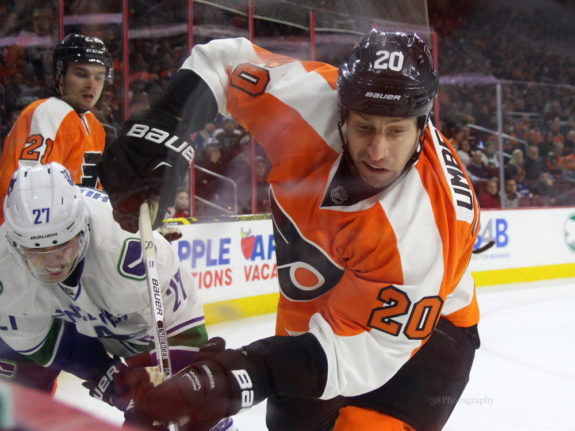
Umberger and Burke’s relationship was tenuous at best, so he probably wouldn’t have done those things with the Canucks. That doesn’t excuse the trade though, as Burke could have obtained a more secure asset for him instead of just a rental.
Best Draft Picks: Henrik & Daniel Sedin (1999, 2nd & 3rd Overall)
Henrik and Daniel Sedin were not only Burke’s best draft picks but two of the top selections in franchise history. Like Smyl before them, the Sedins played their entire career with the Canucks and are now living legends. By the end of their 17-season run, Daniel Sedin was first in goals with 393, Henrik was first in points with 1,070 and both of them were atop the leaderboard in games played with 1,330 and 1,306 games respectively. With over 1,000 points to their name, they also joined an exclusive group that included names like Mike Bossy, Darryl Sittler, and countrymen Daniel Alfredsson and Nicklas Lidstrom.
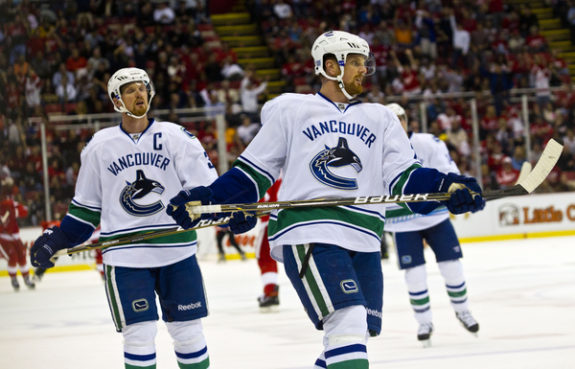
During their careers, they also won an Art Ross Trophy in back-to-back years with Henrik winning it in 2010 and Daniel walking away with it in 2011. Henrik did one up Daniel in one thing though, he won the Hart Trophy as the NHL’s MVP in 2010, while Daniel had to just settle for the Art Ross in 2011. In the end, the Sedins were the best thing to ever come out of the 1999 Draft, as Patrik Stefan and most of the other top picks never really panned out for their respective teams. Burke definitely knew what he was doing when he bent over backward to select them. He saw not only their talent as hockey players but their value as people. Without them, the Canucks would not be the team they are today, and that’s an absolute fact.
Worst Draft Pick: Nathan Smith (2000, 23rd Overall)
After drafting the Sedins in 1999, Burke wasn’t able to strike oil twice as he drafted a dud in Nathan Smith only a year later. Smith played only 26 games in the NHL and never hit the scoresheet even once. He was a 20-goal scorer in the WHL with the Swift Current Broncos and an average point producer in the AHL but ultimately couldn’t translate his offensive game to the NHL. We all know hindsight is 20/20, but when picks like Brad Boyes (505 points), Justin Williams (797 points), and Niklas Kronwall (432 points) were all still available to Burke, you can’t help but wonder what could have happened if one of them were drafted instead.
1. Pat Quinn (1987-1997)
After counting down 10 GMs, we finally get to the number one spot and it belongs to none other than the late Pat Quinn. At ten iconic years leading the team from the front office and behind the bench, he is still the longest-tenured GM in Canucks history and although he wasn’t the most successful, he did make the most impact. In fact, he was the one that brought them back to respectability after many years of hanging out in the NHL’s basement.
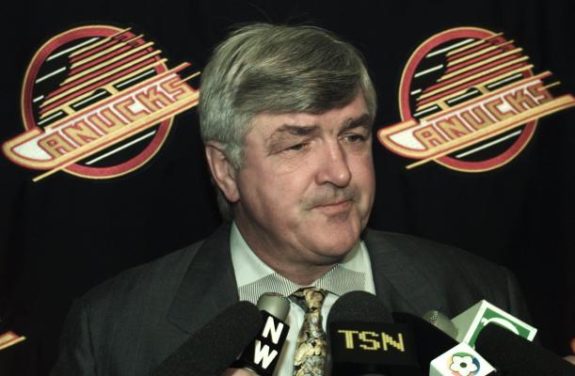
Under his leadership, the Canucks became known as a hardworking, lunch pail group who would fight tooth and nail to win. They basically were an extension of the man they called The Big Irishman. Over the decade he was at the helm, they made the playoffs a franchise-best seven times and came within a win of the Stanley Cup in 1994. In fact, his astute work on the draft floor and on the phones built that 1994 team from the ground up. Led by draft picks Trevor Linden and Pavel Bure and acquisitions, Kirk McLean, Jeff Brown, Brett Hedican, Nathan Lafayette, Cliff Ronning, Geoff Courtnall, Sergio Momesso, Dana Murzyn, Jyrki Lumme, and Greg D Adams, they made history with a run that is still remembered fondly to this day.
Quinn never won a Stanley Cup in his career but he lives on in the hearts and minds of everyone that knew him and is deservedly at the top of this list. Like the Sedins did for the team as players, he did as a GM and coach. His personality, character, and leadership provided a bedrock that is still around today, not only for the Canucks but for the NHL as a whole.
Quinn’s Highs & Lows
Best Trade: Alek Stojanov for Markus Naslund
Of the many successful trades Quinn made, the deal that brought Naslund to the Canucks was by far the best. By the time Naslund left the team in 2008, he had accumulated 346 goals and 756 points in 884 games, served as captain for seven seasons, and won two Viking Awards, the Ted Lindsay Award, and was a three-time NHL All-Star.
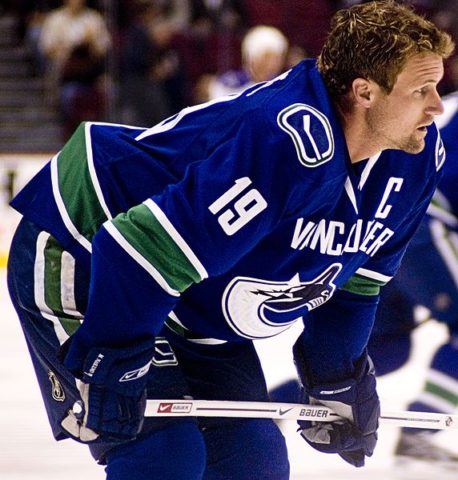
Naslund also became an integral part of the team’s offence during the West Coast Express days with Bertuzzi and Morrison and only dropped below 20 goals once in the decade he was with the Canucks.
No Bad Trades
Quinn did not have any overly bad trades. Surprisingly, most of them turned out to be revolutionary for the Canucks as they helped build the teams which entertained the faithful for most of the early 90s.
Best Draft Pick: Pavel Bure (1989, 113th Overall)
Ah yes, The Russian Rocket, the man most teams thought wasn’t eligible for the 1989 Draft, except for Quinn and his head scout Mike Penny, of course. They ended up drafting the future superstar all the way down in the sixth round, much to the chagrin of every GM on the draft floor. From the minute Bure stepped foot onto North American ice, his tremendous speed, hands and shot were the envy of the NHL. When he was on the ice, you knew something special was going to happen.
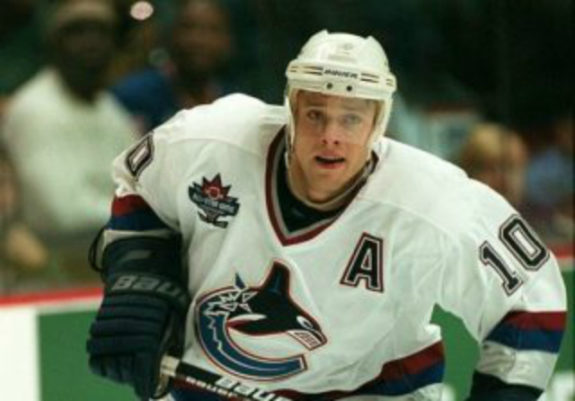
Bure became one of the Canucks’ most lethal threats, posting back-to-back 60-goal seasons in 1992-93 and 1993-94 and a 51-goal season in 1997-98. He also lit it up in the playoffs during the 1994 Stanley Cup run when he recorded 16 goals and 31 points in 24 games. Steal doesn’t even begin to describe his selection at 113th overall.
Worst Draft Pick: Alek Stojanov (1991, 7th Overall)
Unfortunately, Quinn couldn’t get as lucky with the draft as he did on his trade calls. Stojanov never turned into the tough goal scorer he was hyped up to be and ended up playing only 107 games in the NHL. For a seventh-overall pick, that is pretty disappointing. Fortunately for Quinn and the Canucks, he erased his mistake by trading him to the Penguins for Naslund, who became an elite NHLer that more than made up for the potential Stojanov was supposed to bring.
Recapping the Rankings
- Pat Quinn
- Brian Burke
- Jake Milford
- Mike Gillis
- Bud Poile
- Dave Nonis
- Harry Neale
- Jim Benning
- Phil Maloney
- Jack Gordon
- Hal Laycoe
- Mike Keenan (acting)
The Canucks were lucky to have arguably three of the best GMs in NHL history in Burke, Quinn, and Milford, but unlucky to have Keenan and Gordon as well. For the most part, the leadership from the front office has been pretty strong even though a Stanley Cup has never come out of it. The current version of the team has potential, but as we have seen in the past, a GM can put together all the right pieces (1982, 1994, 2011), but still fall short. Hopefully, this list doesn’t expand too much before that happens again.
Do you agree with my rankings? How would you rank the GMs in Canucks’ history? Sound off in the comments below!
Stats and information provided by Elite Prospects, Hockey Reference, Hockey DB, Wikipedia and NHL Trade Tracker